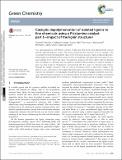Files in this item
Catalytic depolymerisation of isolated lignins to fine chemicals using a Pt/alumina catalyst : part 1—impact of the lignin structure
Item metadata
| dc.contributor.author | Bouxin, Florent P. | |
| dc.contributor.author | McVeigh, Ashley | |
| dc.contributor.author | Tran, Fanny | |
| dc.contributor.author | Westwood, Nicholas James | |
| dc.contributor.author | Jarvis, Michael C. | |
| dc.contributor.author | Jackson, S. David | |
| dc.date.accessioned | 2015-03-18T13:01:02Z | |
| dc.date.available | 2015-03-18T13:01:02Z | |
| dc.date.issued | 2015-02-01 | |
| dc.identifier | 159497203 | |
| dc.identifier | 4c421d9b-4303-4884-b662-6b5ae2d18c93 | |
| dc.identifier | 000349315200066 | |
| dc.identifier | 84922786003 | |
| dc.identifier.citation | Bouxin , F P , McVeigh , A , Tran , F , Westwood , N J , Jarvis , M C & Jackson , S D 2015 , ' Catalytic depolymerisation of isolated lignins to fine chemicals using a Pt/alumina catalyst : part 1—impact of the lignin structure ' , Green Chemistry , vol. 17 , no. 2 , pp. 1235-1242 . https://doi.org/10.1039/c4gc01678e | en |
| dc.identifier.issn | 1463-9262 | |
| dc.identifier.other | ORCID: /0000-0003-0630-0138/work/56424148 | |
| dc.identifier.uri | https://hdl.handle.net/10023/6259 | |
| dc.description | The research reported here was funded by BBSRC and a consortium of industry partners comprising the IBTI Club. The NMR component of this work (FT, NJW) was funded by the EPSRC grants EP/J018139/1 and EP/K00445X/1 and through the International Training Network SuBiCat. | en |
| dc.description.abstract | Four lignin preparations with different contents of alkyl aryl ether bonds were depolymerised using an alumina supported platinum catalyst. The results showed that the proportion of β-O-4 linkages is the crucial factor for both the yield and the nature of the monomeric products. Highly condensed lignin generated mainly non-alkylated phenolic products while uncondensed lignin generated mainly phenolic products retaining the 3-carbon side-chain. These phenolic products with the 3-carbon chain still attached were considerably less abundant than the maximum potential yield calculated from selective cleavage of alkyl aryl ether bonds by thioacidolysis, demonstrating that scope for improved yield remains. Although the catalytic conversion yield rose with increasing content of labile ether linkages in the lignin structure, optimisation of the catalytic depolymerisation was increasingly required to minimize side reactions. Gel permeation chromatography showed that the products converged towards the same molecular weight distribution regardless of the starting material. The full potential of the highly uncondensed lignin was reached only after the minimisation of condensation reactions during the catalytic conversion. | |
| dc.format.extent | 1167287 | |
| dc.language.iso | eng | |
| dc.relation.ispartof | Green Chemistry | en |
| dc.subject | QD Chemistry | en |
| dc.subject | NDAS | en |
| dc.subject.lcc | QD | en |
| dc.title | Catalytic depolymerisation of isolated lignins to fine chemicals using a Pt/alumina catalyst : part 1—impact of the lignin structure | en |
| dc.type | Journal article | en |
| dc.contributor.sponsor | EPSRC | en |
| dc.contributor.sponsor | European Commission | en |
| dc.contributor.sponsor | EPSRC | en |
| dc.contributor.sponsor | EPSRC | en |
| dc.contributor.institution | University of St Andrews. School of Chemistry | en |
| dc.contributor.institution | University of St Andrews. EaSTCHEM | en |
| dc.contributor.institution | University of St Andrews. Biomedical Sciences Research Complex | en |
| dc.identifier.doi | 10.1039/c4gc01678e | |
| dc.description.status | Peer reviewed | en |
| dc.identifier.grantnumber | EP/K00445X/1 | en |
| dc.identifier.grantnumber | SUBICAT | en |
| dc.identifier.grantnumber | EP/J018139/1 | en |
| dc.identifier.grantnumber | EP/J018139/1 | en |
This item appears in the following Collection(s)
Items in the St Andrews Research Repository are protected by copyright, with all rights reserved, unless otherwise indicated.

